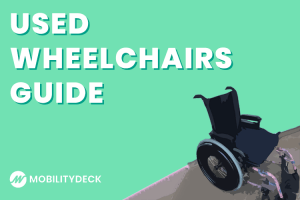- Wheelchairs
- Our Quality Guarantee
- Last Updated November 30, 2025

What is the Minimum Doorway Width for Wheelchair Access?
For able-bodied people, the world just works. There’s very little thought given to staircases, tight corners, slopes and doors. Unless an entrance or exit is unusually shaped, accessibility isn’t even a consideration for most people. But those people with reduced mobility find themselves adapting to each doorway as if a new obstacle, so it’s useful to have important numbers on hand:
The ADA disability standards require that the minimum door width for wheelchair access be 32 inches. This is considered the minimum clear doorway width for wheelchair access, and is generally a “safe” number for most wheelchairs on the market.
Despite this, while it’s true the world is getting more accessible for wheelchair users, there’s still plenty of places they will find it difficult to go. The ADA standards are not mandatory in all states (although there are many reasons they should be). Hopefully, in the next few years, the government will make this issue a priority and introduce legislation to ensure all public entryways, at least, are fully accessible.
What to Do If Your Business Entryways Are Inaccessible
If you’re a business owner, depending on the state you operate in, you may be legally responsible for providing fully accessible doorways of 32 inches or wider. Even if there’s no legal requirement, there’s surely a moral consideration to be had. In this scenario, there’s no need or reason to wait until a mandatory wheelchair width is introduced. You can go ahead and modify your property at any time to make it wheelchair accessible.
The optimum width for a wheelchair accessible entryway is 32 inches across or above. Many older doorways are between much narrower in width. Whilst less than 32 inches may be wide enough for a narrow wheelchair, it will cause problems for anybody whose wheelchair dimensions are broader.
If the doorways of your business are too narrow, adapt them by remodeling walls and fixtures. While the task may require some building work, it’s a fairly simple job. Although, in some cases, internal wiring and switches positioned next to entryways may also require relocation.
Building Wheelchair Friendly Doorways in Your Home
If you live in a home with inaccessible entryways, you can apply for a government grant to reduce the cost of renovations and remodeling. The Specially Adapted Housing Grant is a scheme that helps disabled people pay for essential remodeling in their home.
When remodeling, don’t forget to take connecting hallways and entrance-ways into account. For instance, if there is a tight turn needed to get through the entryway, an even wider door width may be required for comfortable use than the minimum you would expect.
Why Not Buy a Narrower Wheelchair Instead?
If you live in a home with narrow doorways but you can’t afford renovations or don’t have the authority to make the necessary modifications, it might be worth investing in a narrow wheelchair or a transport chair instead. Some chairs on the market reach as low as twenty inches in overall width.
Other types of specially designed pediatric transport chair go as low as fourteen inches in width! At this size, you would be able to pass through an entryway of less than 24 inches. With a narrow chair, the degree of clearance needed to get through a doorway is much smaller than it might be for a full size wheelchair.
Whether or not you should invest in a narrow wheelchair depends on a variety of factors. Is your primary home wheelchair friendly? Are there places you can’t easily pass through in a full sized chair and does this limit your daily activities? Does the town or city where you live impose mandatory ADA doorway widths? If not, could you comfortably switch to a narrow wheelchair when moving around outside your home?
It’s worth noting many narrow wheelchairs require some level of mobility to operate. They may not be suitable for those with little to no mobility or anybody who depends on round the clock care. But, if you can use a narrow chair, consider the cost of buying one in comparison to the cost of property renovations. In the long term, it is worth spending lots of money on modifications or is a narrow chair a suitable solution?
More Wheelchair Related Articles:
Articles You May be Interested In:












